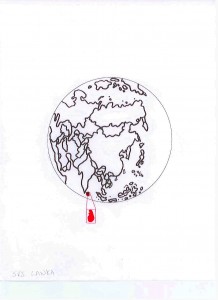SRI LANKA
A. THE COUNTRY
The Democratic Socialist Republic of Sri Lanka is an island nation in
South Asia, off the southern coast of the Indian subcontinent.
Government is a unitary semi-presidential system. Extremists fought for
an independent Tamil state in the north and east and were eventually
defeated in 2009. A political solution to the Sinhala-Tamil issue is
still needed, as the social grievances that led to the uprising remain,
and a strong Tamil diaspora continues to agitate for greater autonomy
for Tamils in Sri Lanka. Much of the nation’s infrastructure is
damaged, but tourism and foreign investment are rising quickly now. The
financial burden of so many unemployed, displaced peoples is a major
economic drain. Textiles, tea and other agricultural commodities are
important and, increasingly, telecommunications and finance. A large
source of income is remittances sent home by many who work abroad.
B. THE PEOPLE
The population is ~20,500,000 and official languages Sinhala and Tamil,
with English as the link language. ~75.9% are Sinhala, ~14.3% Tamil,
~8.3% Sri Lankan Moor, ~1.5% Other South Asian.
C. RELIGIONS AND CHRISTIANITY/PENTECOSTALISM
Buddhism is the national religion and is protected and promoted.
Freedom of religion is assured by law. Anti-conversion initiatives and
sporadic violence against Christians occur as a result of some extreme
Buddhist groups.
~70.02% are Buddhist, ~12.8% Hindu, ~8.52% Muslim, ~8.38% claim to be
Christian, ~0.2% Non-religious, ~0.07% Baha’i, ~0.01% Sikh.
In the Christian category:
~6.92% are Catholic, ~0.77% Protestant, ~0.68% Independent, ~0.16%
Anglican. Evangelicals represent ~1.2% of the population.
Charismatics represent ~1.6% and of those ~0.9% are Pentecostals.
Donna Siemens
References:
http://en.wikipedia.org
Operation World, Jason Mandryk. Colorado Springs: Biblica Publishing, 2010.

